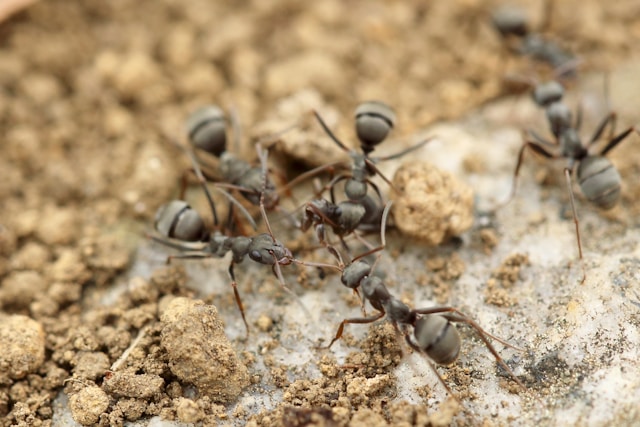At first glance, the rear end of an ant may not seem like a groundbreaking subject for scientific research. But over the decades, the “ant butt” — technically the gaster, or terminal section of an ant’s body — has been at the center of fascinating breakthroughs across biology, chemistry, engineering, and even medicine. From chemical communication to bioengineering inspiration, this tiny anatomical feature has helped scientists uncover some of nature’s most intriguing secrets. Here are 10 times the ant butt played a major role in scientific discoveries.
1. Discovery of Pheromone Trails
One of the most significant breakthroughs in insect behavior came when scientists discovered that ants use their gasters (rear ends) to secrete pheromones — chemical signals that help other ants follow trails to food or navigate back to the colony. This discovery, made in the 1950s, opened up the entire field of chemical ecology and led to deeper understanding of how insects communicate without sound. It also became foundational in developing pest control methods based on disrupting pheromone trails.
2. Defense Mechanisms and Acid Spray
Some ants, especially formicine ants, can use their butts to spray formic acid as a defense mechanism. The ability to aim and shoot acid at predators using abdominal muscles was first documented by researchers in the 1970s and has been studied in greater detail ever since. This defense strategy inspired research into chemical weaponry, non-lethal defense sprays, and even targeted delivery systems in biotech.
3. Social Immunity in Colonies
Researchers have found that ant butts can play a role in what scientists call “social immunity.” Ants use their gaster to secrete antimicrobial compounds that help protect the colony from pathogens. A 2018 study showed that ants use these secretions during grooming to sterilize each other, reducing the spread of disease. This discovery contributed to the broader understanding of social health in eusocial insects and opened up discussions around communal disease prevention in dense populations.
4. Navigation Using Sunlight and Scent Glands
Scientists have shown that ants rely on Dufour’s glands, located near the end of the gaster, to deposit chemical markers during travel. These scents, along with visual cues from the sun, help ants build internal maps. This was crucial to the development of biological models of navigation, which in turn contributed to the creation of autonomous robots and GPS-free navigation systems that mimic ant behavior.
5. Inspiration for Bioadhesives
Certain ants, like the Colobopsis saundersi, rupture their abdominal glands in self-sacrifice to defend the nest, releasing a sticky, toxic fluid. Studying this behavior led scientists to analyze the chemical composition of the adhesive secretions from the gaster. This research has inspired developments in bioadhesives, particularly for medical applications such as wound closure and drug delivery.
6. Ant Butt and Agriculture: The Leafcutter Symbiosis
In leafcutter ant colonies, the ants use their gasters to help fertilize the fungal gardens they cultivate. Scientists discovered that ants apply fecal droplets to leaves to help the fungus break them down. This form of external digestion, made possible through the gaster, was key in understanding mutualism in agriculture — how two species can evolve together to enhance survival. It’s even provided insight into early agricultural development in human history.
7. Identification of New Ant Species
The structure of the gaster — its shape, color, and segmentation — has been instrumental in identifying and classifying new ant species. In many cases, visual examination of the gaster under a microscope helps taxonomists distinguish between nearly identical species. This has helped build comprehensive ant family trees and deepen our understanding of insect evolution and biodiversity.
8. Discovery of Exploding Ants
In Southeast Asia, scientists discovered a species known as Colobopsis explodens, which uses its enlarged gaster to rupture in a last-ditch defensive act, releasing sticky, toxic goo onto attackers. This extreme form of self-sacrifice was first documented in a 2018 study and fascinated entomologists around the world. The behavior showcased the complexity of social insect defense and inspired research into mechanical rupture systems for engineering purposes.
9. Ant Butt Signals in Queen Reproduction
In certain ant species, queen ants emit pheromones from their gasters to signal their fertility and suppress reproduction in worker ants. This discovery played a key role in understanding reproductive hierarchies and the hormonal control mechanisms in eusocial species. It also led to broader insights into how behavior is chemically regulated in complex societies, even drawing parallels to hormonal control in vertebrates.
10. Robotics and the Ant Gait
While not directly about the ant butt alone, researchers studying how ants move found that the positioning of the gaster plays a role in their stability and balance, especially when carrying heavy loads. High-speed cameras and motion-tracking showed that ants use their abdomen to shift weight and remain agile. These findings were applied in robotics to help design legged robots that can walk over uneven terrain, balance loads, and maintain stability using a similar principle.
Conclusion
Who would’ve thought that something as small and overlooked as an ant’s butt could play such a massive role in shaping scientific discovery? From pioneering communication systems and bio-inspired adhesives to evolutionary classification and robot engineering, the ant gaster has quietly advanced our knowledge in biology, chemistry, and technology. It’s a reminder that even the tiniest body part of the tiniest creature can be full of scientific potential — if we’re curious enough to explore it.
FAQs
1. What is the “ant butt” actually called?
Scientifically, the “ant butt” is referred to as the gaster, which is the bulbous terminal part of the abdomen in ants and other Hymenoptera. It houses many critical glands and organs.
2. Why do ants have stingers in their butts?
Some ant species have evolved stingers in their gasters, which they use for defense or hunting. These stingers can inject venom or spray chemicals to deter predators or rivals.
3. Do all ants use their butts to communicate?
Most ants use their gasters to secrete pheromones, which are essential in non-verbal communication like marking trails, warning of danger, or regulating reproduction within the colony.
4. What’s the weirdest thing ants do with their butts?
Possibly the strangest is the “exploding” behavior of Colobopsis explodens ants, which rupture their own gasters in a defensive act that kills them but protects the colony.
5. Can studying ants really help humans build better robots?
Yes! The way ants walk, balance, and coordinate their movements — including how they position their gasters — has directly influenced the development of robotic systems that mimic ant locomotion and stability.







